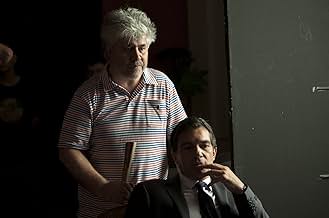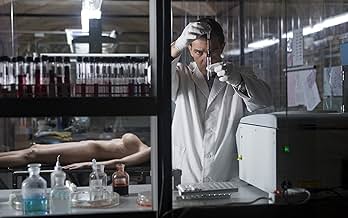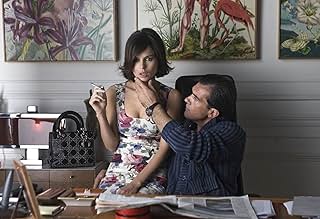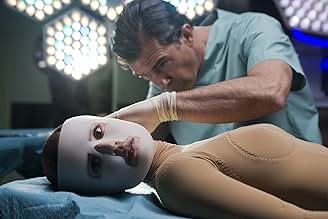Un brillante cirujano plástico, perseguido por tragedias pasadas, crea un tipo de piel sintética que resiste cualquier tipo de daño. Su conejillo de indias, una mujer misteriosa y inestable ... Leer todoUn brillante cirujano plástico, perseguido por tragedias pasadas, crea un tipo de piel sintética que resiste cualquier tipo de daño. Su conejillo de indias, una mujer misteriosa y inestable que tiene la llave de su obsesión.Un brillante cirujano plástico, perseguido por tragedias pasadas, crea un tipo de piel sintética que resiste cualquier tipo de daño. Su conejillo de indias, una mujer misteriosa y inestable que tiene la llave de su obsesión.
- Dirección
- Guionistas
- Elenco
- Ganó 1 premio BAFTA
- 28 premios ganados y 69 nominaciones en total
- Dirección
- Guionistas
- Todo el elenco y el equipo
- Producción, taquilla y más en IMDbPro
Opiniones destacadas
I will finally hit subjectivity and say that less and less often the film is able to cause anything other than: disgust, laughter or such a sad moment of crying, let's call it pity. I don't know.
But this movie! Everything is different here. Everything somehow shrank inside after the plot twist at the end and it was a great feeling.
It seems like the main villain of the film causes empathy, and the main character, he is the person who lost the most, appears to the viewer, on the contrary, not in the best possible way.
And with such ambivalent feelings, you sit and watch the climax. An indescribable feeling. Be sure to try it!
A Spanish mystery about a plastic surgeon who practiced skin transplant.
First of all, there were quite a lot of explicit contents here. Not sure if it's necessary.
The most fascinating part was middle part of the movie with a long flashback that showed what happened to the surgeon and how he dealt with the aftermath. And oh boy that was disturbing and gross.
Through this messed-up story was the theme of retribution and obsession. It showed a disturbing way that a person could bring about retribution.
Overall, a disturbing story with great acting. 7.5/10.
Dr Robert Lesgard (Antonio Banderas) is a renowned surgeon who is attempting to achieve a breakthrough in bio-medical sciences by creating a synthetic skin through transgenisis. Classified as a horrific mutation by some, and acknowledged by Robert as an innovation, his experiments come at a price. His human test subject is a beautiful woman named Vera (Elena Anaya) who is contained within his home, and cared for by his head servant Marilia (Marisa Paredes). Vera is not like other women, she wears a skin-coloured suit made out of fabric instead of clothes, she is constantly watched by Robert and Marilia, and she never leaves her room, which only Robert himself holds the key too. What follows is a startling journey of discovery as the narrative unravels a story of disturbing past, present and future events; transforming the lives of all those involved.
Beginning in Toldeo in 2012, Almodovar utilizes a constantly underused and under-appreciated device in the nonlinear narrative. He provides the audience with one perception of each character before returning in flashback during the second act to six years previously where further events are explained and through this, the audience's initial observations of the characters become undermined and drastically altered. He then digresses between past and present at will building a comprehensive picture of each character involved as the story develops revealing some startling and disturbing discoveries. This decision to structure the film in this way, also adequately supplements Almodovar's need to explore his key themes including sexual identity, and the nature of the moral of ethics of the human soul after it has been literally stripped bare.
Coupled with the beautiful cinematography from Almodovar's long-time collaborator Jose Luis Alcaine and an original and complimentary score by Alberto Iglesias, 'The Skin I Live In' also becomes an example of technically proficient filmmaking which works alongside the performances of the likes of Banderas and Anaya, as well as the slickly written script which keeps the audience on their toes until the final curtain has been dropped. Pedro Almodovar is undoubtedly one of the most successful auteurs of the last few decades, and with 'The Skin I Live In' he shows that he can almost touch upon a new genre, in the form of body horror genre-hybrid, whilst also retaining all the previous elements, themes and techniques which have made his films the deep-seated critically successful films that they are.
The order in which the events of the story are told is a cunning device that allows the director to make us reflect on how superficially - indeed, skin-deep - we perceive reality and how quick we are to judge first impressions and jump to conclusions. What we first perceive one way, those initial scenes that slightly baffle us but which we nevertheless do not hesitate to judge in a specific way, take on a completely new meaning when the story pauses to take us back into the past in order to tell us about an important series of events that happened at the time which bear a direct relation to present events. The new light that is shed on the present changes completely our perception of the story as we had first witnessed it, which is a humbling experience. We are then taken back again to the present and continue watching the rest of the film, but with this completely new understanding of the real underlying motivations for the characters' actions. It is at this point that through a slight thriller-style twist in the plot the story takes on a Shakespearean dimension as it delivers its powerful humanist lesson that vengeance begets vengeance.
Food for thought, in fact enough food to last you days and feed other people, as you are left on the one hand wondering at the concept of skin: what we actually desire when we desire someone, whether all desire is skin-deep, whether the skin does not allow us to see the person behind. And on the other hand you are left with the reflection on how the road of vengeance leads only to self-destruction. When a film leaves you pondering so deeply, I can only conclude it is a great film.
In the end its a gorgeous looking, philosophically complex mystery and horror film. Although not gory, this is a disturbing work, both on a literal story level, and also for the questions it raises about identity, love, sado-masochism, and passion run amok.
These themes are all Almodovar touchstones, but delivered here with a visually stunning icy touch, and with much more complete logic than in his early works, which often felt less fully thought through, and had more frustrating plot holes and character leaps.
Not a 'scary' film, but a creepy, moody and highly effective one. A dark fairy tale as told by, say Stanley Kubrick.
It's good to see Antonio Banderas reunited with Almodovar, and he delivers a wonderfully complex and quirky modern day Dr. Frankenstein.
Less emotional than my two very favorite Almodovar films (Talk to Her, All About My Mother), but its exciting to see this extremely talented film maker continue to evolve and grow, and I think this represents work that can stand among his best.
¿Sabías que…?
- TriviaAfter a few days of shooting, Pedro Almodóvar had a conversation with Antonio Banderas in which he told Banderas that he needed to drop all of his tics as an actor, because the director wanted a really restrained character and the actor was playing him in a more typical psycho way.
- ErroresWhen Doctor Robert Ledgard and his colleagues are preparing themselves for surgery, they fasten each other's surgical gown from the back, contaminating their sterile gloves.
- Citas
Profesora de Yoga en TV: There's a place where you can take refuge. A place inside you, a place to which no one else has access, a place that no one can destroy.
- Créditos curiososAt the start of the end credits, there is a rotating DNA double helix in the background.
- ConexionesFeatured in At the Movies: Cannes Film Festival 2011 (2011)
- Bandas sonorasPor el amor de amar
(Versión Castellana)
Written by Jean Manzon and José Toledo
Performed by / interpretada por CONCHA BUIKA (Buika), al piano Iván González Lewis (as Iván 'Melón' Lewis)
© 1960, by Jean Manzon & Jose Toledo.
Autorizado para todo el mundo a Universal Music Publishing, S.L.
Todos los derechos reservados.
Grabado en CATA (Madrid).
Selecciones populares
Detalles
- Fecha de lanzamiento
- Países de origen
- Sitios oficiales
- Idiomas
- También se conoce como
- The Skin I Live In
- Locaciones de filmación
- Productoras
- Ver más créditos de la compañía en IMDbPro
Taquilla
- Presupuesto
- EUR 10,002,914 (estimado)
- Total en EE. UU. y Canadá
- USD 3,185,812
- Fin de semana de estreno en EE. UU. y Canadá
- USD 223,119
- 16 oct 2011
- Total a nivel mundial
- USD 33,716,389
- Tiempo de ejecución2 horas
- Color
- Mezcla de sonido
- Relación de aspecto
- 1.85 : 1

![Ver Tráiler [OV]](https://m.media-amazon.com/images/M/MV5BODliMDVlYjQtN2U1OC00MGVlLWE5YWEtNDk5OTMzMGZkOGFhXkEyXkFqcGdeQXRodW1ibmFpbC1pbml0aWFsaXplcg@@._V1_QL75_UX500_CR0)




































